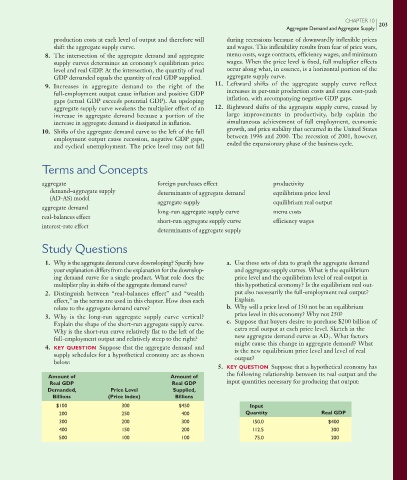Page 232 - Economics
P. 232
CONFIRMING PAGES
CHAPTER 10
203
Aggregate Demand and Aggregate Supply
production costs at each level of output and therefore will during recessions because of downwardly inflexible prices
shift the aggregate supply curve. and wages. This inflexibility results from fear of price wars,
8. The intersection of the aggregate demand and aggregate menu costs, wage contracts, efficiency wages, and minimum
supply curves determines an economy’s equilibrium price wages. When the price level is fixed, full multiplier effects
level and real GDP. At the intersection, the quantity of real occur along what, in essence, is a horizontal portion of the
GDP demanded equals the quantity of real GDP supplied. aggregate supply curve.
11. Leftward shifts of the aggregate supply curve reflect
9. Increases in aggregate demand to the right of the
full-employment output cause inflation and positive GDP increases in per-unit production costs and cause cost-push
gaps (actual GDP exceeds potential GDP). An upsloping inflation, with accompanying negative GDP gaps.
aggregate supply curve weakens the multiplier effect of an 12. Rightward shifts of the aggregate supply curve, caused by
increase in aggregate demand because a portion of the large improvements in productivity, help explain the
increase in aggregate demand is dissipated in inflation. simultaneous achievement of full employment, economic
growth, and price stability that occurred in the United States
10. Shifts of the aggregate demand curve to the left of the full
employment output cause recession, negative GDP gaps, between 1996 and 2000. The recession of 2001, however,
and cyclical unemployment. The price level may not fall ended the expansionary phase of the business cycle.
Terms and Concepts
aggregate foreign purchases effect productivity
demand–aggregate supply determinants of aggregate demand equilibrium price level
(AD-AS) model
aggregate supply equilibrium real output
aggregate demand
long-run aggregate supply curve menu costs
real-balances effect
short-run aggregate supply curve efficiency wages
interest-rate effect
determinants of aggregate supply
Study Questions
1. Why is the aggregate demand curve downsloping? Specify how a. Use these sets of data to graph the aggregate demand
your explanation differs from the explanation for the downslop- and aggregate supply curves. What is the equilibrium
ing demand curve for a single product. What role does the price level and the equilibrium level of real output in
multiplier play in shifts of the aggregate demand curve? this hypothetical economy? Is the equilibrium real out-
2. Distinguish between “real-balances effect” and “wealth put also necessarily the full-employment real output?
effect,” as the terms are used in this chapter. How does each Explain.
relate to the aggregate demand curve? b. Why will a price level of 150 not be an equilibrium
price level in this economy? Why not 250?
3. Why is the long-run aggregate supply curve vertical?
Explain the shape of the short-run aggregate supply curve. c. Suppose that buyers desire to purchase $200 billion of
Why is the short-run curve relatively flat to the left of the extra real output at each price level. Sketch in the
full-employment output and relatively steep to the right? new aggregate demand curve as AD 1 . What factors
might cause this change in aggregate demand? What
4. KEY QUESTION Suppose that the aggregate demand and is the new equilibrium price level and level of real
supply schedules for a hypothetical economy are as shown output?
below:
5. KEY QUESTION Suppose that a hypothetical economy has
the following relationship between its real output and the
Amount of Amount of
input quantities necessary for producing that output:
Real GDP Real GDP
Demanded, Price Level Supplied,
Billions (Price Index) Billions
$100 300 $450 Input
200 250 400 Quantity Real GDP
300 200 300 150.0 $400
400 150 200 112.5 300
500 100 100 75.0 200
mcc26632_ch10_187-207.indd 203 8/21/06 4:51:12 PM
8/21/06 4:51:12 PM
mcc26632_ch10_187-207.indd 203

